A Guide to the Wide World of Hummus, According to Reem Kassis
Because there's more to it than the stuff in the tub.
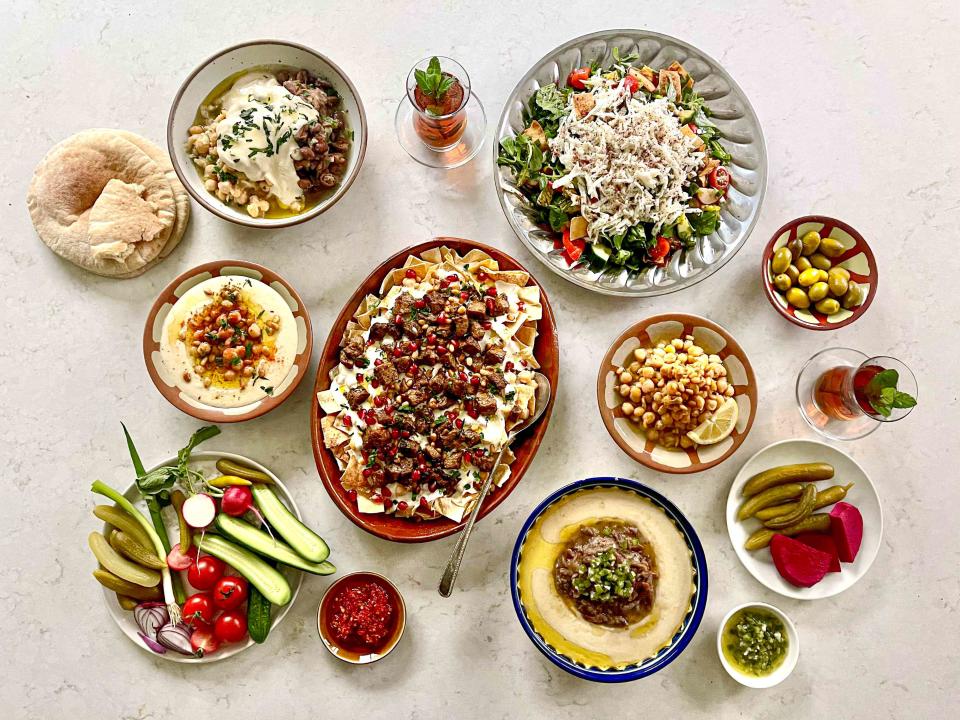
Serious Eats / Mai Kakish
Picture narrow, cobbled streets. Locals are chatting, with some rushing to get a headstart on the day’s errands, and colorful fabrics float around shop doors. The air is filled with the scent of spices and freshly baked bread. If you listen carefully past all the bustle in and around Jerusalem’s Old City—where I grew up and still think of as home—there’s a rhythmic pounding. That noise is the unmistakable sound of cooks mashing chickpeas and tahini for hummus. In Jerusalem, hummus isn’t just a dish—it’s a cultural icon.
The city's hummus shops, often family-owned and passed down through generations, are gathering spots for a diverse set of characters. They’re where imams and priests, the rich and the poor, and tourists and locals alike find common ground. The menus, if they exist, are straightforward, and are often just handwritten lists on the wall. On them you’ll find hummus b’tahini, a quintessential Palestinian dish, and its various iterations garnished with pine nuts or meat. You may also see local favorites like msabaha, a dish of loose chickpeas with tahini, and qudsiyeh, hummus topped with fava beans.
While hummus has become an increasingly popular staple in the United States, most people are only familiar with its most basic form: hummus b’tahini. In Arabic, the word hummus simply means chickpeas; hummus b’tahini refers to the version where cooks mash the humble chickpea with tahini paste, itself often milled just down the street from the hummus shop. It's a worthy dish, but one that barely scratches the surface of the chickpea’s culinary depth.
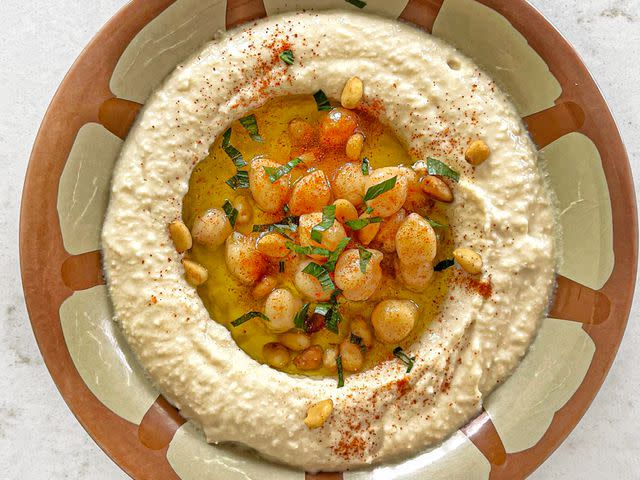
Serious Eats / Mai Kakish
Branches of other enticing dishes have since grown from this fundamental dish. If you stroll the old city streets of Jerusalem, Amman, Beirut, or Damascus and walk into hummus shops that have been around for generations, hummus b’tahini is but one of many options on the menu where its myriad “cousins'' share in the spotlight, offering a taste of the region’s culinary diversity.
The exact dishes and how they are presented may vary from shop to shop, as they naturally would from family to family. Even the names might differ depending on which city, neighborhood, or country you find yourself in. My knowledge of these dishes is informed by a childhood spent between Jerusalem and the Galilee, where my paternal grandparents lived. It was there that my palate learned to distinguish the nuances of a humble plate of hummus.
I can immediately tell when there’s too much lemon juice or citric acid, or if there’s an unpleasant soapiness that comes from soaking or cooking your chickpeas with too much baking soda. I can feel the gritty consistency from beans that weren’t cooked until they were truly tender. And I can taste when a dip has, or lacks, the distinct nuttiness of tahini. Conversations overheard amongst friends and family around which shop made a better plate may have colored my view on what makes a certain hummus “the best,” but over the years, I’ve learned that, for the most part, there’s no right or wrong answer, simply personal preferences. It’s no surprise that most people have a favorite dish; and with the number of options available at hummus shops, it’s hard to go wrong. The dishes below are just a few examples, and illustrate how loved the chickpea is among Arab cuisines.
Essential Dishes You'll Find at Hummus Shops
Msabaha (Hummus With Whole Chickpeas)
The word itself comes from the Arabic verb “to swim.” In Jerusalem, “msabaha” refers to a dish of warm chickpeas tossed (or swimming) in a loose tahini sauce with garlic, chiles, and lemon, which is similar to baleela mentioned below. Msabaha is what some might call deconstructed hummus. In the Galilee, they call it mshawasheh, which, humorously, simply means confused.
Hummus Fatteh (Hummus With Crisp Pita, Fried Meat, and Toasted Pine Nuts)
To make this dish, cooks top toasted day-old bread with warm chickpeas and a tahini sauce, along with buttery pine nuts, morsels of fried lamb, and a punchy lemon chile dressing. (A vegetarian version uses more chickpeas and pine nuts in place of the meat.) It’s one of many fatteh-style dishes, where people transform old bread into a more substantial meal by combining it with a soup, salad, or stew.
Qudsiyeh (Hummus Topped With Fava Beans)
Al-Quds is the Arabic name for Jerusalem. Directly translated, this eponymous dish means native to Jerusalem and refers to hummus b’tahini topped with cooked fava beans. It probably has other names throughout the Levant, and many refer to it by its basic description as “hummus ma ful” or hummus with ful. Most humus shops make both of these dishes, so even in a place that doesn’t serve up qudsiyeh, it’s not uncommon for someone to ask for a dish of half and half and essentially receive qudsiyeh!
Baleela (Creamy Chickpeas With Cumin and Pine Nuts)
Originally a simple street snack of warm chickpeas dusted with cumin, the dish is now a staple at restaurants, where it’s available in a slightly more elevated form as a part of a mezze spread. I make my baleela by lightly mashing the boiled chickpeas with some of its flavorful cooking liquid, then season it with garlic and lemon juice to add a sharp, savory flavor.
Makhloota (Chickpeas and Fava Beans With Tahini)
In Arabic, “makhloota” simply means “mixed together.” In this case, the name refers to the combination of lightly crushed chickpeas and fava beans in the dish, which comes with a lemon garlic dressing and tahini sauce. The ingredients vary depending on where it’s made, and can include an assortment of different legumes and grains, like lentils, kidney beans, wheat berries, or bulgur wheat.
The History of Hummus
How did one legume—the chickpea—become such an essential part of Arab cuisine? Archaeological evidence suggests that humans first domesticated the chickpea around the 10th millennium BCE in the Fertile Crescent. How it spread throughout the Middle East, South Asia, Ethiopia, and the Western Mediterranean remains a mystery, but the legume has been a staple crop throughout much of the Levant since ancient times. According to historian Andrew Dalby, the author of Food in the Ancient World From A to Z, Palestinians were cultivating chickpeas by 8000 BC.
At some point, someone had the innovative idea to pound chickpeas with tahini, a rich sesame seed paste. One of the earliest mentions of this concept is in the 13th-century Syrian cookbook Al-Wusla ila al-Habib al-Tayyibat wal-Teeb, which culinary historian Charles Perry has translated into English as Scents and Flavors: A Syrian Cookbook. The cookbook details a simple recipe that calls for mashing cooked fresh chickpeas, then topping it with a tahini and vinegar blend followed by layers of crushed walnuts, lemon juice, and spices like cinnamon and coriander and herbs like mint and parsley.
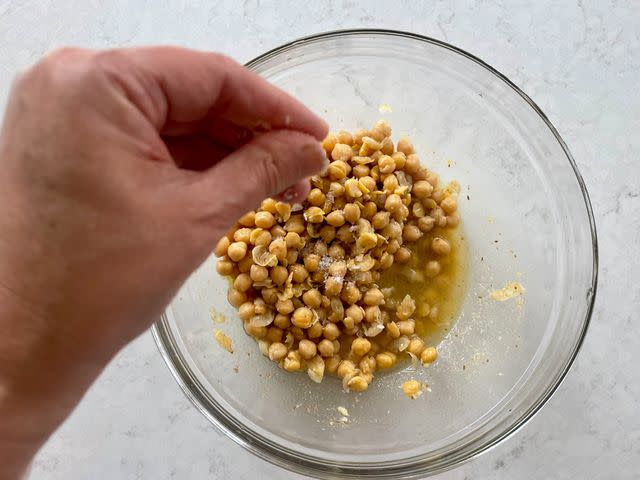
Serious Eats / Mai Kakish
Some netizens claim that hummus appears in the Torah and the Bible and therefore means the dish predates medieval Arabic cookbooks. Scholars, however, have refuted these assertions by illustrating how the references in both Ruth 2:14 and Isaiah 30:24 more accurately describe vinegar or animal feed produced from fermented chickpeas, rather than the contemporary version of hummus. Though the origins of hummus remain contested, the spread’s appearance in Scents and Flavors suggests that that hummus as we know it today likely first emerged in what is now Syria.
History aside, once we go past the basic plate of hummus b’tahini, there are many more delicious ways to enjoy the chickpea. The names of these dishes sometimes vary by locale, so if you recognize a recipe under a different name, you may very well be right. These are simply the versions that I grew up with as a Palestinian.
Regardless of their names, the recipes I’ve shared here should serve as a blueprint for the many ways you can prepare chickpeas and their trusty sidekick, fava beans. There are myriad possibilities and I recommend you approach this guide in that spirit. This is not a scientific text meant to be followed to a tee (although if you do, you will have some delicious dishes to enjoy!).
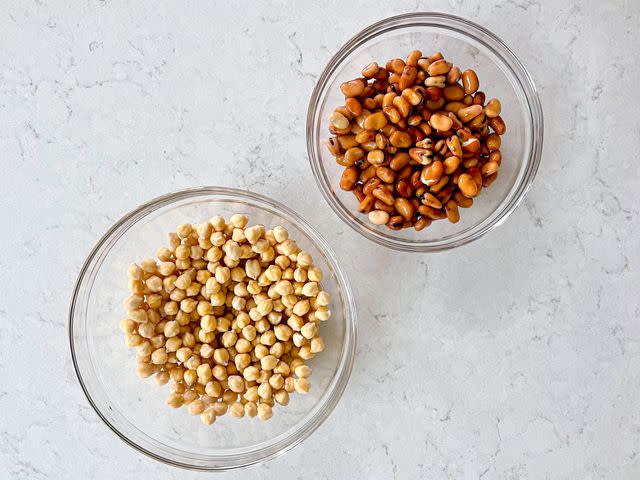
Serious Eats / Mai Kakish
Rather, I want to show how certain ingredients, like cumin, lemon, and garlic can elevate these earthy beans, or how tahini can brighten their flavor, or how nuts and toasted bread can add texture. If you’re short on time, start with my hummus b’tahini, which is made with canned or jarred chickpeas and will show you just how quick and easy it is to whip up hummus whenever you want. If you have more time on your hands, you can start by boiling a pot of chickpeas—because from there, you’ll have so many options for what to do.
Guiding Principles
Legumes are wonderfully versatile and delicious. Affordable and sustainable, they're packed with protein and fiber that keep you fuller for longer. It’s incredibly easy to prepare large batches of legumes, and they’re an efficient and nourishing way to feed large families. Chickpeas and fava beans are the most common legumes used in Palestinian cuisine and within other parts of the Levant. It is no surprise that, when possible, many families—including those in Gaza facing starvation—rely on this most basic food group to sustain themselves during times of need.
Not only are chickpeas nutritious and tasty, but they’re also relatively simple to prepare. It’s hard to mess up chickpeas: They make a satisfying and delicious meal even when they’re just boiled, dusted with salt and cumin, and eaten as is. Still, there are several guiding principles to keep in mind as you work with legumes like chickpeas and fava beans. The tips below are ones I swear by, and will help you make the most of legumes so you can enjoy them in as many ways as possible.
Don’t Be Afraid to Use Jarred or Canned Legumes
One of the best modern conveniences is the availability of jarred or canned legumes. Yes, they are usually inferior to their dried and freshly boiled counterparts—but given the time constraints many of us (including myself) face, it’s better to go for the pre-cooked variety if the alternative is to skip this food group entirely.
Nowadays, there are good-quality options for canned or jarred varieties that offer exceptional quality and flavor. To make the most of these beans, though, I recommend you drain and rinse them very wellto remove any unpleasant flavors from the can that may linger and control the amount of liquid before proceeding with your recipe. If you need flavorful cooking liquid, you can reheat the beans by placing them in a saucepan, covering them in water, and simmering them with some ground cumin and a whole garlic clove (cumin’s citrusy smokiness alongside the sharp fruitiness of garlic makes them perfectly complementary to chickpeas) for 10 to 15 minutes.
…But It’s Worth Making Your Beans From Scratch
Still, boiling your own legumes is an investment that pays dividends. While I call for cooking small quantities of beans in the recipes shared here, I generally hesitate to do so because soaking and preparing beans takes time. So I recommend you double (or even quadruple) the amount and freeze them in airtight containers for quick, easy meals down the road.
Fresh Is Best
It’s especially important to use fresh ingredients when preparing a dish as simple as hummus, as there’s no place for anything to hide. Bottled lemon juice just doesn’t stand up to the bright sharpness of freshly squeezed lemon juice, and pre-peeled garlic, while convenient, will never be as flavorful as fresh garlic that’s just been crushed or grated. Same goes for herbs like parsley. As for cumin, it may take a bit more effort, but toasting and grinding your own at home is truly a way to take a dish from good to sublime. The stuff in stores is never that fresh and almost certainly not toasted before being ground. But again, if this is what is going to stop you from making hummus, then go ahead and make it with what’s easily and readily available—it’s better than not making it at all!
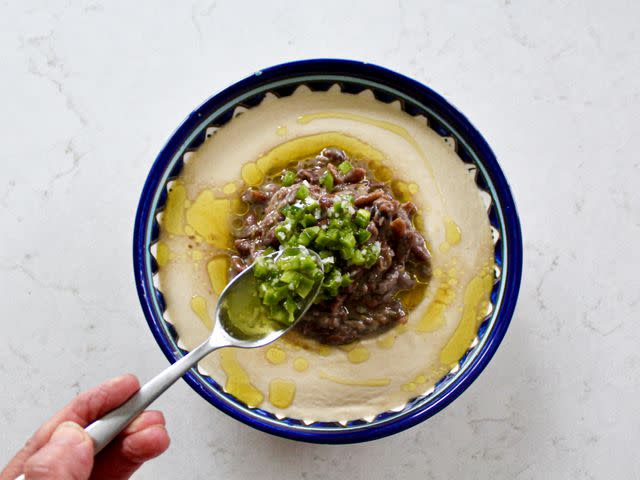
Serious Eats / Mai Kakish
If you can swing it, I recommend investing in some good extra-virgin olive oil that tells you when exactly it was harvested and where it comes from. Store it in a cool, dark place to prevent oxidation. Olive oil is what lifts all of these dishes and brings them together—if you have good-quality olive oil, this is absolutely the place to use it.
Use Your Senses
Once you’ve taken care of these essentials, the rest will take care of itself as you prepare hummus and its variations. The most important thing I’ve learned over the years is that hummus demands a certain alchemy, or nafas— what I described as “a certain intimacy that stretches beyond the physical attributes of a dish” for the New York Times— to truly shine.
There's no single recipe for a perfect plate of hummus; even the most seasoned cooks will find variations in flavor with each batch. While enthusiasts might debate over the best methods for preparing chickpeas—from soaking and peeling to the ideal ratios of tahini, lemon, and spices—achieving sublime hummus transcends these technicalities. It's about the convergence of skill and senses—touch, sight, sound, and, of course, taste—in the hands of the person bringing it to life.
The only way to make extraordinary hummus is taking the time to understand the myriad nuances of cuisine, which are often the result of years or generations of experience. This isn't meant to deter you from making hummus, but rather to inspire you to continuously experiment. Only through practice and repetition will you be able to really develop the sense for what makes a plate of hummus perfect for you.
Read the original article on Serious Eats.

